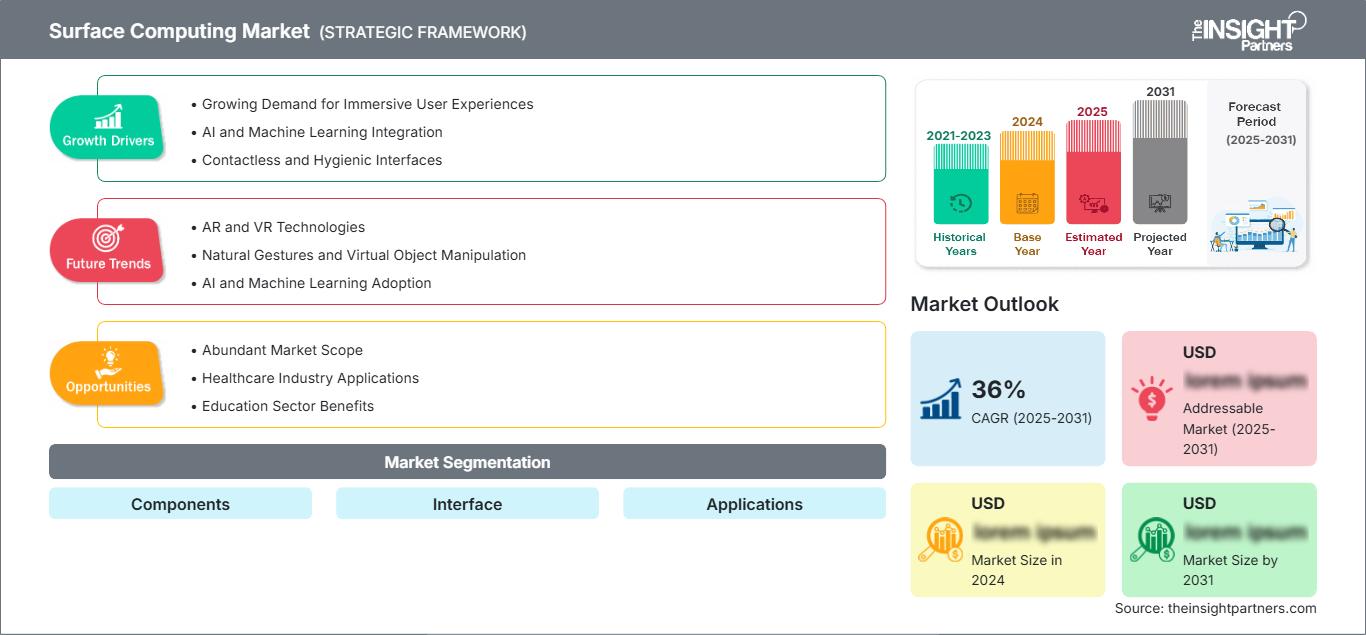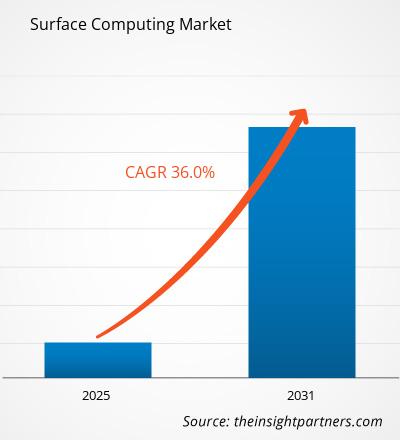Si prevede che il mercato del Surface Computing raggiungerà i 2012,55 miliardi di dollari entro il 2031. Si prevede che il mercato registrerà un CAGR del 30,3% nel periodo 2025-2031.
Il rapporto di ricerca di mercato del Surface Computing è segmentato in vari sottosegmenti per componenti. Il rapporto fornisce inoltre un'analisi basata su tipi di interfaccia e applicazioni, inclusi settori come quello accademico e aziendale. L'analisi globale è suddivisa a livello regionale e per i principali paesi. La valutazione del mercato è presentata in dollari USA per l'analisi segmentale di cui sopra.
Scopo del rapporto
Il rapporto "Surface Computing Market" di The Insight Partners mira a descrivere il panorama attuale e la crescita futura, i principali fattori trainanti, le sfide e le opportunità. Ciò fornirà spunti a vari stakeholder aziendali, come:
- Fornitori/produttori di tecnologia: per comprendere le dinamiche di mercato in evoluzione e conoscere le potenziali opportunità di crescita, consentendo loro di prendere decisioni strategiche informate.
- Investitori: per condurre un'analisi completa delle tendenze in merito al tasso di crescita del mercato, alle proiezioni finanziarie del mercato e alle opportunità esistenti lungo la catena del valore.
- Organismi di regolamentazione: per regolamentare le politiche e le attività di controllo nel mercato con l'obiettivo di ridurre al minimo gli abusi, preservare la fiducia degli investitori e sostenere l'integrità e la stabilità del mercato.
Componenti di segmentazione del mercato del Surface Computing
Interfaccia
Applicazioni
Geografia
- Nord America
- Europa
- Asia-Pacifico
- America meridionale e centrale
- Medio Oriente e Africa
Potrai personalizzare gratuitamente qualsiasi rapporto, comprese parti di questo rapporto, o analisi a livello di paese, pacchetto dati Excel, oltre a usufruire di grandi offerte e sconti per start-up e università
Mercato del Surface Computing: Approfondimenti strategici

-
Ottieni le principali tendenze chiave del mercato di questo rapporto.Questo campione GRATUITO includerà l'analisi dei dati, che vanno dalle tendenze di mercato alle stime e alle previsioni.
Fattori di crescita del mercato del surface computing
- Crescente domanda di esperienze utente immersive: la crescente necessità di modalità intuitive e coinvolgenti per interagire con i contenuti digitali sta alimentando la domanda di surface computing.
- Integrazione di intelligenza artificiale e apprendimento automatico: il progresso delle tecnologie di intelligenza artificiale e apprendimento automatico migliora i sistemi di surface computing, consentendo interazioni intelligenti e personalizzate.
- Interfacce contactless e igieniche: la natura igienica delle interfacce touchless, che ha acquisito importanza dopo il COVID, si allinea bene con la crescita del surface computing.
- Progressi tecnologici e riduzione dei costi: i continui miglioramenti tecnologici e la riduzione dei costi stanno accelerando la crescita del mercato del surface computing.
Tendenze future del mercato del surface computing
- Tecnologie AR e VR: la realtà aumentata (AR) e la realtà virtuale (VR) continueranno a migliorare il surface computing, offrendo esperienze utente immersive e interattive.
- Gesti naturali e manipolazione di oggetti virtuali: il surface computing consentirà agli utenti di manipolare oggetti virtuali attraverso gesti naturali, fondendo il mondo fisico e quello digitale in modi innovativi.
- Adozione di intelligenza artificiale e apprendimento automatico: una maggiore integrazione di intelligenza artificiale e apprendimento automatico renderà il surface computing più intuitivo e personalizzato, grazie a una migliore comprensione delle intenzioni dell'utente.
- Soluzioni ecocompatibili: una crescente consapevolezza guiderà lo sviluppo di display a basso consumo e tecnologie di recupero energetico per un surface computing più sostenibile.
Opportunità di mercato per il surface computing
- Ampio ambito di mercato: il mercato del surface computing offre vaste opportunità per aziende e innovatori, con nuove applicazioni emergenti in vari settori.
- Applicazioni nel settore sanitario: il surface computing può migliorare la formazione medica, le procedure chirurgiche e l'assistenza ai pazienti attraverso tecnologie interattive e immersive.
- Vantaggi per il settore dell'istruzione: nell'istruzione, il surface computing promuove la creatività e le esperienze di apprendimento interattive, favorendo il coinvolgimento degli studenti.
- Innovazione nel settore della vendita al dettaglio: il surface computing consente raccomandazioni personalizzate sui prodotti e migliora l'interazione dei clienti con gli espositori dei prodotti nello spazio di vendita al dettaglio.
Mercato del Surface Computing
Le tendenze regionali e i fattori che influenzano il mercato del Surface Computing durante il periodo di previsione sono stati ampiamente spiegati dagli analisti di The Insight Partners. Questa sezione illustra anche i segmenti di mercato e la geografia della gestione delle malattie del ritmo cardiaco in Nord America, Europa, Asia-Pacifico, Medio Oriente e Africa, America meridionale e centrale.
Ambito del rapporto di mercato del Surface Computing
| Attributo del rapporto | Dettagli |
|---|---|
| Dimensioni del mercato in 2024 | US$ XX Billion |
| Dimensioni del mercato per 2031 | US$ 2012.55 Billion |
| CAGR globale (2025 - 2031) | 30.3% |
| Dati storici | 2021-2023 |
| Periodo di previsione | 2025-2031 |
| Segmenti coperti |
By ComponentiBy InterfacciaBy ApplicazioniBy Geografia
|
| Regioni e paesi coperti |
Nord America
|
| Leader di mercato e profili aziendali chiave |
|
Densità degli operatori del mercato del Surface Computing: comprendere il suo impatto sulle dinamiche aziendali
Il mercato dei Surface Computing è in rapida crescita, trainato dalla crescente domanda degli utenti finali, dovuta a fattori quali l'evoluzione delle preferenze dei consumatori, i progressi tecnologici e una maggiore consapevolezza dei vantaggi del prodotto. Con l'aumento della domanda, le aziende stanno ampliando la propria offerta, innovando per soddisfare le esigenze dei consumatori e sfruttando le tendenze emergenti, alimentando ulteriormente la crescita del mercato.

- Ottieni il Mercato del Surface Computing Panoramica dei principali attori chiave
Punti di forza
- Copertura completa: il rapporto analizza in modo esaustivo prodotti, servizi, tipologie e utenti finali del mercato del Surface Computing, offrendo una panoramica olistica.
- Analisi degli esperti: il rapporto è redatto sulla base della conoscenza approfondita di esperti e analisti del settore.
- Informazioni aggiornate: il rapporto garantisce la pertinenza aziendale grazie alla copertura di informazioni e tendenze dei dati recenti.
- Opzioni di personalizzazione: questo rapporto può essere personalizzato per soddisfare le esigenze specifiche del cliente e adattarsi in modo appropriato alle strategie aziendali.
Il rapporto di ricerca sul mercato del Surface Computing può quindi contribuire a guidare il percorso di decodificazione e comprensione dello scenario del settore e delle prospettive di crescita. Sebbene possano esserci alcune valide preoccupazioni, i vantaggi complessivi di questo rapporto tendono a superare gli svantaggi.
- Analisi storica (2 anni), anno base, previsione (7 anni) con CAGR
- Analisi PEST e SWOT
- Valore/volume delle dimensioni del mercato - Globale, Regionale, Nazionale
- Industria e panorama competitivo
- Set di dati Excel
Report recenti
Testimonianze
Motivo dell'acquisto
- Processo decisionale informato
- Comprensione delle dinamiche di mercato
- Analisi competitiva
- Analisi dei clienti
- Previsioni di mercato
- Mitigazione del rischio
- Pianificazione strategica
- Giustificazione degli investimenti
- Identificazione dei mercati emergenti
- Miglioramento delle strategie di marketing
- Aumento dell'efficienza operativa
- Allineamento alle tendenze normative






















 Ottieni un campione gratuito per - Mercato del Surface Computing
Ottieni un campione gratuito per - Mercato del Surface Computing